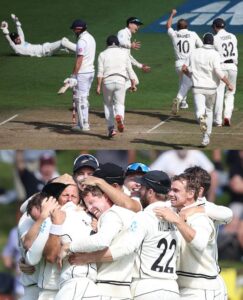
The South African-born second-change bowler with the stats of a legend is perhaps unique in the game’s history. Oh, and Sehwag was Bazballing a generation ago.
In the last decade of Test cricket, ten bowlers have taken 250 wickets or more. It’s an illustrious list too. Stuart Broad, who leads the way with 404, and James Anderson are statistically the greatest bowling combination in the game’s history. R Ashwin (388) and Ravindra Jadeja (251) will eventually leave cricket with records far superior to any of their illustrious spin-bowling predecessors from India. Kagiso Rabada (268 wickets) has a strike-rate (40.3) that’s unmatched in the game’s history.
Nathan Lyon (403 victims in the past ten years) could finish his career with twice as many wickets as Richie Benaud, No.3 on the Australian spinners’ list behind him and the incomparable Shane Warne. Mitchell Starc will surpass Mitchell Johnson’s tally of 313 Test wickets, the most by an Australian left-arm pacer, either in India or during the Ashes later this year. Tim Southee (294) and Trent Boult (287) are the greatest new-ball pairing in New Zealand’s cricket history.
It’s the identity of the man at No.9 on the chart that will raise more than a few eyebrows. It’s not Josh Hazlewood or Pat Cummins, both of whom have already done enough to take their place in Australia’s pace pantheon. Nor is it Mohammed Shami, so central to Indian cricket’s most successful era. This man is the only one on the list without ten five-wicket hauls, and the only one to not have taken 10 in a Test. Yet, his strike-rate of 51.1 is bettered only by Rabada, Starc (49.1) and Ashwin (50.3).
Only six times in a career that stretches back to July 2012 has he shared the new ball. Mostly, he has been the fourth bowler that his captains have called on. He hasn’t taken a five-wicket haul since 2019, and turns 37 in less than a fortnight. He’s also just won New Zealand a Test match in the most incredible circumstances, taking 4-62 on the final day to deny England and Bazball a seventh straight Test win.
Welcome to Neil Wagner’s world. The closest he came to playing for his native South Africa was two games as 12th man at Centurion, just down the road from where he grew up in Pretoria. Those with agendas, or just too lazy to do the research, will mutter darkly about the ‘quota system’ and how it impacted those like Wagner. But if you look at those South African pace bowlers who have taken 100 or more Test wickets since Wagner came into contention, you’ll find Dale Steyn and Morne Morkel at the top of the list.
Jacques Kallis is also in there, though he took only one five-wicket haul after 2006. The ‘quota’ players on the list are Rabada, Vernon Philander and Makhaya Ntini, and you’d need to have your head examined for fecal matter if you thought any one of that trio didn’t deserve his place in the XI. The reality is that Wagner, along with the likes of Kyle Abbott and Andre Nel, missed out on more appearances because South Africa had so many options to call on.
It’s also undeniable that Wagner has done his best work in pace-friendly conditions in New Zealand. As many as 39 of his 62 Test caps have been won on ‘home’ turf, and a whopping 176 wickets (out of 258) have been snaffled on those pitches. Compared to the others on the top-10 list of the decade, Wagner is a fairly limited bowler too. There isn’t a skill that Anderson doesn’t have, while Rabada and Starc could blast you out even on a benign pitch. If the ball is moving off the seam, then there are few bowlers more dangerous than Broad.
Wagner, by contrast, has always been a combination of enforcer and workhorse. What is truly incredible is how long he has thrived while performing that role. With the emergence of Kyle Jamieson (72 wickets at a strike-rate of 43.9 in his 16 Tests), there was a danger of Wagner being surplus to requirements. But with Jamieson now recovering from back surgery, to fix an injury sustained last June, Wagner was pretty much the last throw of the dice as the match slipped away from New Zealand at the Basin Reserve in Wellington.
A hobbling Ben Stokes and the free-stroking Joe Root had added 121 to rescue England from the depths of 80-5, and the new ball was still more than 20 overs away when Tim Southee called on Wagner to do his thing. He had dismissed Ollie Pope in his first over earlier in the day, caught cutting to second slip, but five further overs in that spell had yielded no reward.

Called on to bail his side out, Wagner did what he does best. Though he’s no longer searingly fast, Wagner still thuds the ball into the middle of the pitch and gets it to rear up at the batsmen. And while he isn’t express, the pace is lively enough to make the cross-batted stroke a risk. Stokes, mobility clearly hampered by a dodgy knee, was in no sort of position to play the ugly slap that cost him his wicket.
Root, who had batted so beautifully till then, was a fraction late on a pull that looked very pre-meditated. Two wickets in two Wagner overs, and the pendulum had swung back New Zealand’s way. After Ben Foakes and Jack Leach then got England to the threshold, it was Wagner again to administer the decisive blow. It wasn’t as though he had been idle in between either, catching both Broad and Foakes on the boundary.
When the end came, it wasn’t actually even a bouncer. The threat of the short ball had pushed Anderson further and further back in his crease, and the ball barely rose above waist height. The tentative glance down the leg side was brilliantly taken by Tom Blundell, and Wagner had 4-62 for the innings. He had bowled 9.2 overs on the trot in the second spell, the foot soldier who doubles up as battering ram. When he spoke pointedly afterwards of some things meaning more than five-wicket hauls, you could only nod your head in agreement.
Finally, a word on Bazball itself. While it has unquestionably revived interest in English cricket, and the Test format as a whole, what is laughable is the notion that this began with England in 2022. Way back in 2009, in a Test match against Sri Lanka in Kanpur, Virender Sehwag and Gautam Gambhir added 233 for the first wicket in 41.2 overs. In the very next game at the Brabourne Stadium, India made 443 for 1 on the second day, in just 79 overs. Sehwag’s contribution was an unbeaten 284. Good luck to Harry Brook and friends as they try to match that!





